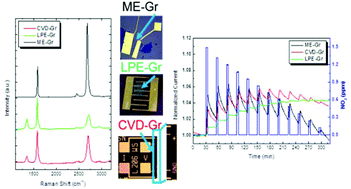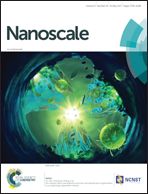Effects of graphene defects on gas sensing properties towards NO2 detection†
Abstract
The crystal structure of graphene flakes is expected to significantly affect their sensing properties. Here we report an experimental investigation on the crystalline structure of graphene aimed at exploring the effects on the gas sensing properties. The morphology of graphene, prepared via Chemical Vapor Deposition (CVD), Liquid Phase Exfoliation (LPE) and Mechanical Exfoliation (ME), is inspected through Raman spectroscopy, Atomic Force Microscopy (AFM) and Scanning Electron Microscopy (SEM). CVD and LPE-graphene structures are found to be more defective with respect to ME-graphene. The defects are due to the jagged morphology of the films rather than originating from intrinsic disorder. The flatness of ME-graphene flakes, instead, explains the absence of defects. Chemiresistors based on the three different graphene preparation methods are subsequently exposed to NO2 in the concentration range 0.1–1.5 ppm (parts per million). The device performance is demonstrated to be strongly and unambiguously affected by the material structure: the less defective the material is, the higher the response rate is. In terms of signal variation, at 1.5 ppm, for instance, ME-graphene shows the highest value (5%) among the three materials. This study, comparing simultaneously graphene and sensors prepared via different routes, provides the first experimental evidence of the role played by the graphene level of defectiveness in the interaction with analytes. Moreover, these findings can pave the path for tailoring the sensor behavior as a function of graphene morphology.



 Please wait while we load your content...
Please wait while we load your content...